Note: If an image ever fails to appear - refresh your page, it really is there
The Historical Flags of Germany Part 2
| Top of the page | The Holy Roman Empire | Prussian Flags Before 1800 | Prussian Flags 1800-1892 |
| Prussian Flags After 1900 | Imperial Germany Era Flags | German Colonial Flags | Weimar Republic Era Flags |
| Third Reich Era Civil and Political Flags | Third Reich Era Military Flags | Modern Era Flags |
Flags of Imperial Germany (Second Reich) 1871-1918
In 1862, a financial crisis arose in the Kingdom of Prussia, when the Diet refused to authorize funding for a proposed re-organization of the army by King William I (Wilhelm I). To end the crisis, the King chose a Prussian nobleman (Junker) named Otto von Bismarck to handle the crisis. The rest is history, not only did Bismarck make Prussia the most powerful and dominant state in Germany, but he also ensured that Prussia would become leader of the Second Reich, the dreamed of united German empire under Prussian leadership.
Bismarck became known as "The Iron Chancellor" and along with Wilhelm established their famous policy of "Blood and Iron," which eventually made Wilhelm the Kaiser (Emperor or Caesar) of Imperial Germany. Wilhelm was proclaimed "German Emperor" on January 18, 1871, in the Hall of Mirrors in the Château de Versailles, after the forces of the German Confederation (under Prussian leadership) defeated the forces of Napoleon III of France in the Franco-Prussian War of 1870.
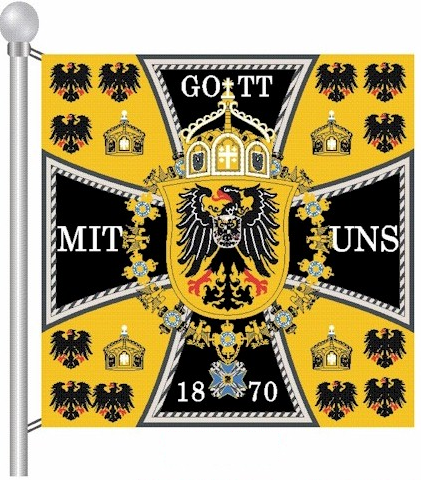
Imperial German Standard

Prussian Royal Standard
|
The Emperor's Standards (Kaisersstandarte) 1871-1918
In the Second German Empire (Second Reich) of 1871-1918, the Emperor used the title "German Emperor" (Deutscher Kaiser). Although William I (Wilhelm I) at first wanted to be called "Emperor of Germany" (Kaiser von Deutschland), for political reasons his Chancellor Otto von Bismarck convinced him to use the title "German Emperor" instead. The difference may seem small today, but it had to do with the other German rulers and princes accepting the King of Prussia as Emperor. Constitutionally, Imperial Germany was a federated empire. "Emperor of Germany" sounded more dictatorial to the other princes and leaders of the newly unified German states, while "German Emperor" sounded more like someone who was simply first among other equals to them.
The new Imperial Standard (Kaiser-Standarte) was a square golden flag with a big iron cross touching the edges of the flag, with inscriptions at each end "GOTT-MIT-UNS" (God with us) and the year "1870." This was because it was in 1870 that the German Empire was first proclaimed in the Hall of Mirrors at Versailles outside of Paris. In each golden quarter there are three black eagles and one golden crown. In the middle a golden shield with a black eagle, over it a golden crown, all surrounded with the chain of the Order of Black Eagle.
Although William I was proclaimed German Emperor, he also kept his position as King of Prussia, as did his successors, Frederick III and William II. As King of Prussia, they also had a similar standard with a red field. On both standards the central shield was surmounted by a crown, the German imperial version for the Emperor's standard and the Prussian royal version for the King's standard. In addition, the eagles were slightly different, that of Prussia having the initials "FR" for Frederick the Great (Fredericus Rex) on its breast and that of Imperial Germany being uncrowned with the Prussian shield and eagle on its breast.
It should also be noted that during the period from 1871 to 1918 there existed three different standards in all. Moreover, the emperor used other flags (for example, a pennant as Commander-in-Chief of the navy) for special occasions. Click here to learn more details about the flags and standards of the German Emperors . |
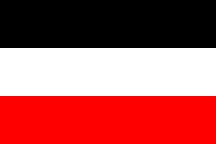
Imperial Tricolor Flag
|
Imperial German Tricolor 1892-1918
The black-white-red striped German imperial flag was adopted by the North German Confederation in 1867, as a combination of the black-white of Prussia and the red-white of Brandenburg. In 1871 it was adopted as merchant flag for the German Empire, and in 1892 declared to be the national flag of the Second Reich and continued in use until 1918. It was briefly reintroduced later just prior to World War II between 1933 and 1935, and used jointly with the Nazi swastika flag, then banned as symbol that could be used by "reactionary" groups.
|
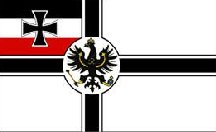
Imperial War Ensign 1813
|
Imperial War Ensign 1867-1892
This naval Imperial War Ensign (Reichskriegsflagge) was used from 1867 to 1892 by both the German Confederation and the Second Reich at sea. It had a white field, a black and white cross, and a small black-white-red flag with a black Iron Cross in the canton.
The Iron Cross was a Prussian order first established by King Frederick William III in 1813 for military valor or patriotic service in the 1813-15 war against Napoleon. It was revived in 1871 for the Franco-Prussian war and in 1914 for the First World War. It was also revived as a German order in 1939 by Hitler.
( Click here to learn more about the history of the Imperial War Flag 1867-1921 ) |
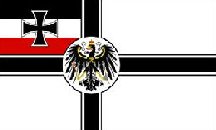
Imperial War Ensign 1892
|
Imperial War Ensign 1892-1903
This was the German War Flag (Reichskriegsflagge) used from 1892 to 1903. It was changed when the Germany army began to use this flag as a war flag on land.
After Wilhelm II succeeded to the Second Reich throne in 1888, this flag, with its redesigned Prussian eagle and Imperial arms overlaid in the middle on a white disc, came into used until the flags last change in 1903.
( Click here to learn more about the history of the Imperial War Flag 1867-1921 ) |
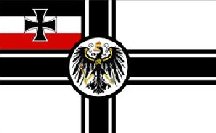
Imperial War Ensign 1903
|
Imperial War Ensign 1903-1919
This was the German War Flag (Reichskriegsflagge) used from 1903 to the end of World War I in 1918. The Kaiser Wilhelm II ordered the design changed in 1902 because he felt it looked too similar to the British White Ensign under certain lighting conditions.
Germany declared war on France in July of 1914 and Russia in August of 1917, coming to the aid of Austria-Hungary.
( Click here to learn more about the history of the Imperial War Flag 1867-1921 ) |

Pseudo War Ensign c1990
(modern replica variant)
|
False Imperial War Ensign 1990
This strange "pseudo" Reichskriegsflagge variant was originally displayed at the German reunification celebrations in 1990. At that time it was described as self-made and a one-of-a-kind flag. It was shown in a picture that is now part of the Deutsches Bundesarchiv collection (German Federal Archive - Bild 183-1990-1003-004). Since then replicas have been available for purchase on several commercial websites.
Because members of the far right have been using the Imperial War Flags as a symbol, its use at public events is considered to be a "breach of the public order" in seven of the German Länder, and the flags are mandatorily confiscated. In the other nine Länder, any provocative misuse of the flag can be also be persecuted as an misdemeanor. Because of this, replica flag like this one have become popular, especially among football fans and can be seen occasionally in the crowds at football games. Their use isn't considered illegal, because although based on the original design, they are not true to actual Imperial War Flags.
|
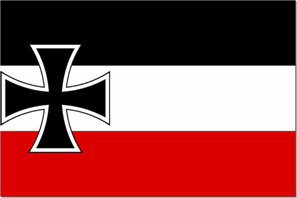
Former Naval Officer's Vessel
|
Merchant Ensign with Iron Cross 1898
German Emperor William II (Kaisar Wilhelm II) authorized the use of a modified version of the Imperial Civil Ensign for former German Naval Officers called the "Merchant Ensign with the Iron Cross" in 1898. |
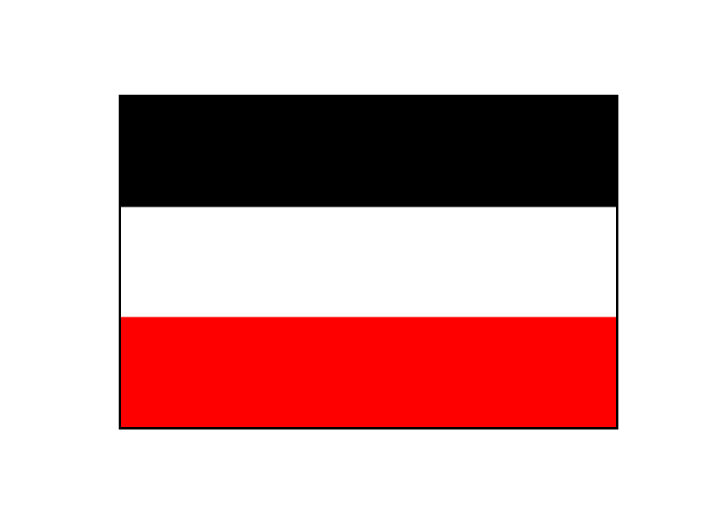
General Pilot's Flag 1876
|
General Pilot's Flag 1876
In 1876, the German General Pilot's flag was designated as the Civil Ensign of smaller size, surrounded by a white stripe of the same width as the other stripes.
This flag was flown when a ship was under the temporary control of a local "maritime" pilot. Pilots are required in restricted waterways where there are congested waters or navigational hazards, such as harbors or river mouths. The pilot was technicality only an advisor, as the captain always remained in command of the vessel, but in most cases the captain followed the advise of the pilot because of their knowledge of possible hazards. |
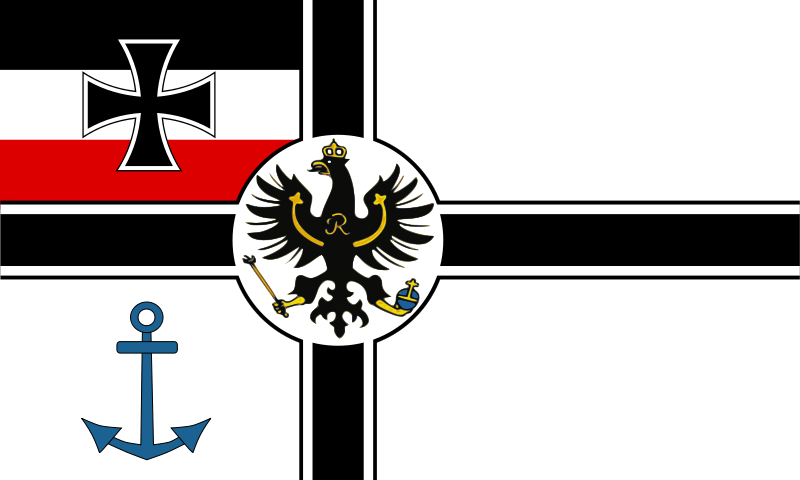
Department of Commerce
Vessel Ensign
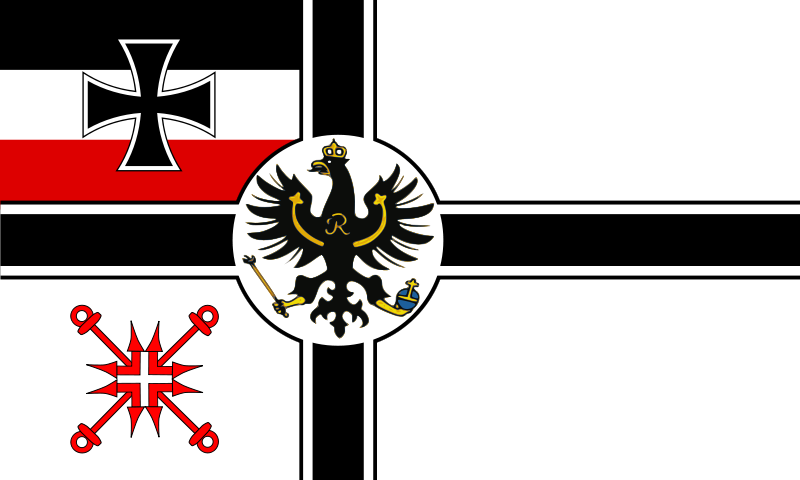
Barges, Auxiliary Hired Vessel
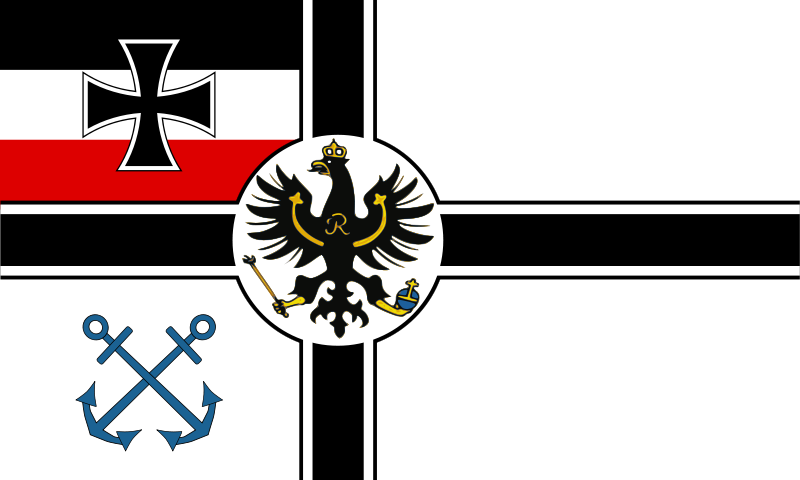
German Pilot Vessel Ensign
|
German Naval Ensigns, Jacks, and Service Flags 1867-1892
All Imperial German Service Flags of the North-German Union and the German Empire are based on the German Naval Ensign flown on the Royal Prussian Navy since 1867.
Special emblems for each service branch were added below the canton and Iron Cross.
|
|
|
Postal Service Vessel Ensign |
|
Customs Service Vessel Ensign |
All these flags had corresponding jacks. There were five jacks in all. Here is an example of the Customs Authorities Jack. They were all the same design, and just exchanged the special emblems for the service branch in the center of the white stripe.
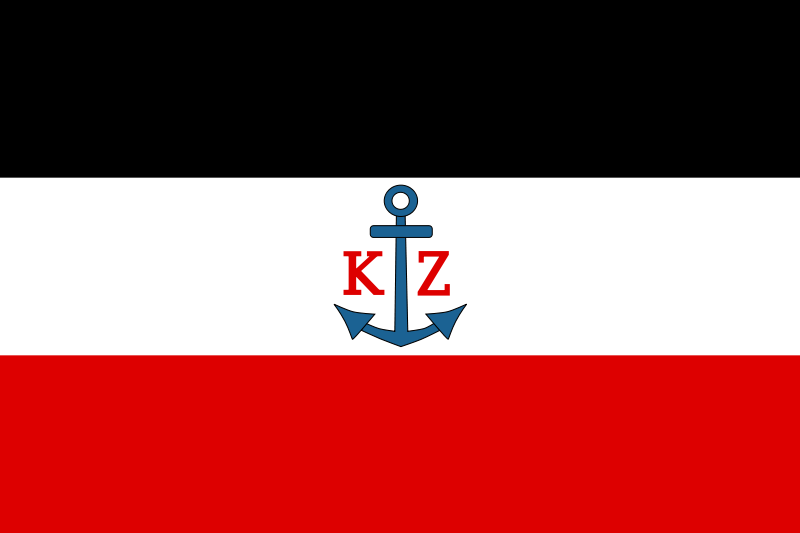
Imperial Customs Service Jack
All German Naval Ensigns, jacks, and Service Flags containing these special signs were used only until 1892, when the flag system was completely changed in Imperial Germany. |
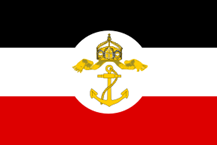
Imperial Service Flag at Sea
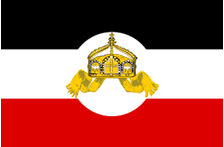
Imperial Service flag on Land
|
German Imperial Service Flags 1893-1918
In 1893, new Service flags were introduced, replacing the five former naval ensigns. Those official authorities, which used flags on sea had to fly the "Dienstflagge der Kaiserlichen Marine" (Service flag of the imperial navy). The remaining authorities had to fly the "Dienstflagge für die übrigen Verwaltungszweige des Reiches" (Service flag for the remaining branches of Reich authorities).
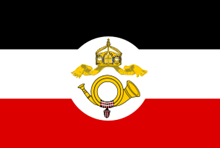
Imperial Postal Service Flag
The postal authorities had to fly their new "Imperial Postal Service flag." |

Imperial Naval Ensign
|
German Naval Jack 1903-1919
This was the jack used by all Imperial German warships between 1903 and 1919 and later briefly reintroduced between 1933 and 1935. It was replaced by the swastika type in 1935.
A jack is a flag that looks like the union or canton of a national war ensign (see Imperial War Ensigns above). On warships, the jack is flown from a flag pole (jack-staff) located on the vessel's front end (bow) when at anchor or in port.
|
| Top of the page | The Holy Roman Empire | Prussian Flags Before 1800 | Prussian Flags 1800-1892 |
| Prussian Flags After 1900 | Imperial Germany Era Flags | German Colonial Flags | Weimar Republic Era Flags |
| Third Reich Era Civil and Political Flags | Third Reich Era Military Flags | Modern Era Flags |
Flags of the German Colonial Empire 1885-1918
As with the development of other European colonial empires of the 19th Century (i.e.- the British, French, and Dutch), it was privately-owned companies which led the way to colonial development, backed by Imperial resources. As Germany became industrialized, after its late unification efforts during the latter part of the 1800s, the Kaiser´s colonial holdings were smaller that those of the older colonial powers and the need for natural resources to feed her growing industry was paramount for the Second Reich.
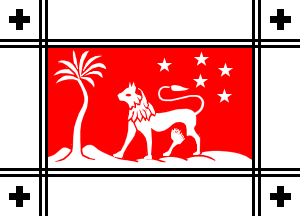
DOAG Company Flag 1885
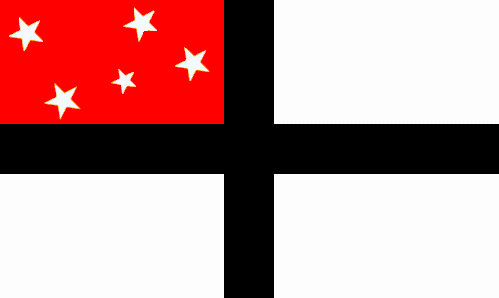
DOAG Company Flag 1895
(Petersflagge - Carl Peters Flag)
|
German East Africa Company 1885-c1918
The German East Africa Company (Deutsch-Ostafrikanische-Gesellschaft) was an organization established at the start of the German colonization of East Africa. This company was responsible for the governing and development of the region for the Second Reich. It had, naturally both positive and negative effects in the region, and was unpopular with the native population.
In 1891, native rebellions made it apparent that the Company could not handle its dominions, and it lost its monopoly to the German government which began to rule German East Africa directly, thus relegating the Company to running some plantations and trade business.
This lesser known East Africa Company flag was used from about 1885 until the company adopted its more popular and well-known flag of 1895. Our drawing shows five-pointed stars, but they may have been four-pointed.
The German East Africa Company began using a new flag about 1895. The nickname of the new flag was the "Carl Peters Flag" (Petersflagge). Dr. Carl Peters was a founder of the Society for German Colonization and he personally designed the new DOAG flag. The Peters Flag became the common model for colonial societies in the period of the Weimar Republic. They were sometimes defaced with individual symbols. (For example, see "German Colonial Society" flag below) After World War I, this flag was the symbol that unified all neo-colonial institutions and organizations. |

DKG Flag after 1920
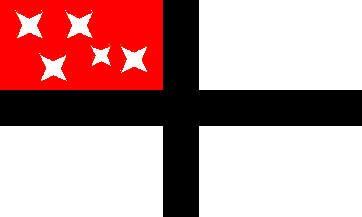
DKG Flag c1939
|
The German Colonial Society 1887-1943
The German Colonial Society (DKG - Deutsche Kolonial-Gesellschaft) was headquartered in Berlin. The Society was formed in 1887 from the membership of the former Society for German Colonization (GDK - Gesellschaft für Deutsche Kolonialisation) and the German Colonial Association (DKV - Deutscher Kolonialverein). Its goal was to win support for German colonization, especially in africa. In 1936, the DKG was made a branch of the Reich Colonial League (RKB - Reichskolonialbund), placed under Nazi control, and survived in that form until it was dissolved in 1943.
The DKG flag's design was obviously based on the flag of the German East Africa Company. On a plain white background a standard Teutonic black cross was centered. The red canton held five white five-pointed stars, which were arranged as a constellation of the Southern Cross. On the black cross the DKG Society emblem was centered, showing a palm tree and the initials "DKG."
Another variation of the DKG flag was used later (c1939) which had no logo and the red canton had five four-pointed stars. One very questionable explanation for the use of the four-pointed star was that they were chosen in order to distinguish them from the five-pointed star of communism and the six-pointed Magen David star. |

Rehoboth Basters
|
Free Republic of Rehoboth 1872
The Basters (also known as Baasters, Rehobothers or Rehoboth Basters) are the descendants of Cape Colony Dutch and indigenous African women. They largely live in Namibia. The name Baster is derived from the Dutch word for "bastard" or "crossbreed." While some people consider this term demeaning, the Basters proudly use the term as an indication of their history.
Following the German annexation of German South-West Africa, the Basters worked with the German colonialists and fought on the German side during the Herero Wars. In 1872, the Basters founded the "Free Republic of Rehoboth," designed a German-influenced national flag and produced a constitution that continues to govern the actions of the Baster to the current day. The cooperation between the Basters and the German Empire ended in 1915 when Germany declared war on the Basters following the Basters´ refusal to assist the German war effort in World War I. |
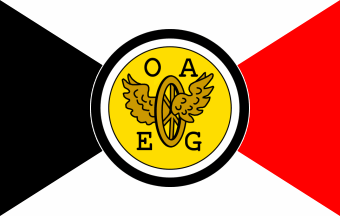
DOAEG Company Flag
|
German East African Railway Company 1904
The German East African Railway Company (Deutsch-Ostafrikanischen Eisenbahn-Gesellschaft) was was founded in 1904 and attempted construction of the Usambara Railway that would connect the Port of Tanga (Mombasa) to Lake Victoria by passing south of the Usambara Mountains, but after taking two years to build 40kms of line, the Usambara Railway ("Usumbara Bahn") was declared bankrupt and construction had to be taken over by the German Government. The line eventually reached Moshi in 1912. The Usambara Railway was the first railway to be built in German East Africa and what is today Tanzania.
The flag of the East African Railway Company was a black and white red diagonally divided flag, on which a circular winged track, as well as the initials of the company, were centered on the flag. |
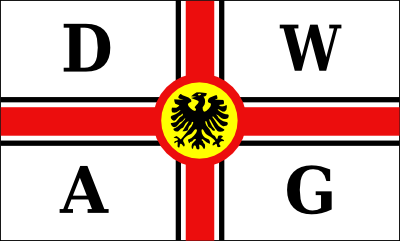
DWAG Company Flag
|
West-Africa Company Flag 1896-1903
The German West African Company (Deutsch-Westafrikanische-Gesellschaft Compagnie), was a German chartered company, founded in 1885. It exploited the two German protectorates in West Africa - Kamerun and Togoland (Togo and Cameroon), but did not actually govern them like was done by its counterpart in German East Africa.
The German West African Company was established as a chartered company with a headquarters in Hamburg. Following years of little profits, the company was absorbed by the German Empire in 1903.
|
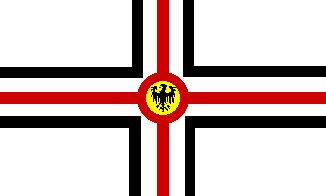
German Colonies West Africa
|
German Colonies West Africa (Questionable)
Deutsche Kolonien-Westafrika
This flag, reportedly found in an obscure and unidentified 1882 source, is a bit of a mystery. It obviously is related to the DWAG Company Flag, but the letters are missing and it reportably predates the company's founding date by a couple of years. Although the source indicated it was a German colonial flag, there doesn't seem to have been a "German West African Colonies" administrative unit at this time, only ones for Togo and Cameroon. These were both German protectorates after 1884.
Unlike other contemporary European countries, the German Empire didn't seem very interest in creating special flags for all their colonies. However, see the Proposed Flags for the German Colonies for examples of flags once under consideration, but not adopted.
|
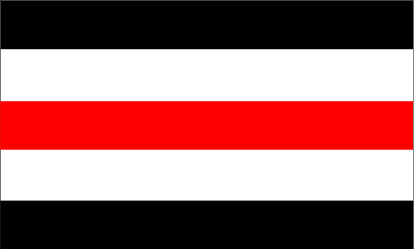
Ralik Islands Flag
|
Flag of the Ralik Islands 1878-1894
The Ralik Islands are part of the Marshall Islands in the Pacific Ocean. In 1878, Captain B. Werner of the German Cruiser SMK Ariadne, signed an agreement with local chiefs to use Jaluit Atoll as a German Coaling station. By 1883, at least 67 ships, of which 11 flew the flag of the Ralik, were re-coaled there. The actual colonization of the Islands by the German Empire began later in 1885.
In 1878, Captain Werner gave a flag to the chiefs on the last day of their stay described in this agreement as the national flag, but with two additional stripes, one white and one black. Apparently the flag was well received by the locals and was used for several years. |
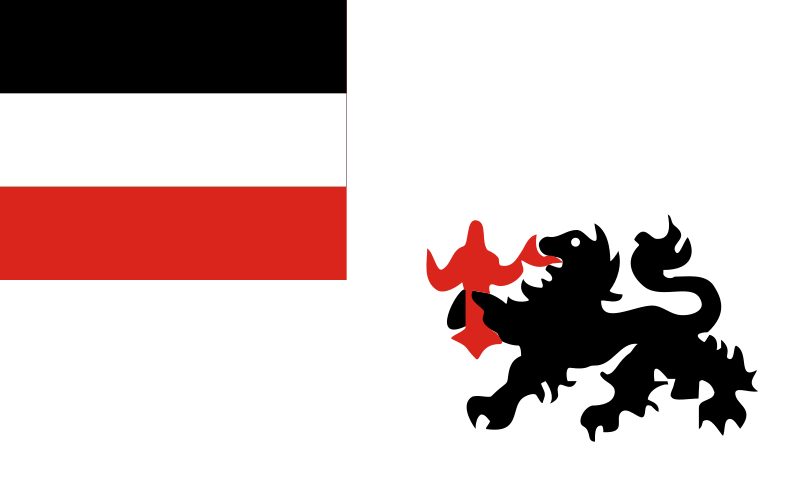
DNGC Company Flag
|
German New Guinea Company 1885-1899
In 1884, the German New Guinea Company (Neuguinea-Kompagnie) was founded in Berlin by Adolph von Hansemann and others for the purpose of colonizing and exploiting resources on Neu Guinea (New Guinea). Its influence soon grew to encompass the entire north-eastern part of New Guinea and some of the islands off the coast. In 1899, the Imperial German Government took official control of the area.
The white flag of the German New Guinea Company showed the Imperial colors in the canton and a black heraldic lion holding a red Bourbon Lily on the fly. |
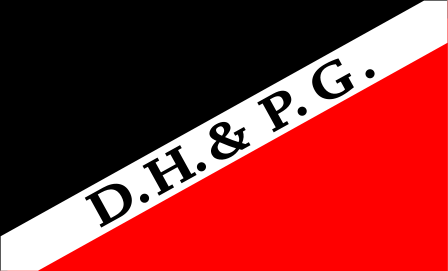
DHPG Company Flag 1880
|
German Trade and Plantation Company of the South Sea Islands
The German Trade and Plantation Company of the South Sea Islands (Deutsche Handels-und Plantagen-Gesellschaft der Südsee Inseln), or "German Trade and Plantation Society of the South Sea Islands of Hamburg" was founded in 1878. The DHPG established a factory and trading station on Jaluit (one of the Marshall islands) at first for the export of coconut oil, but soon had other trading stations on a number of islands.
The flag of the "German trade and plantation Society of the South Sea Islands to Hamburg" was a black and white and Red diagonally split flag with the initials of the company in the white stripes. |
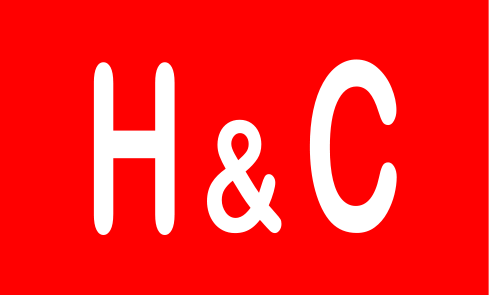
H&C Flag
|
Hernsheim & Company 1880
The commercial exploitation of what was to become the major export commodity of the Marshall Islands, copra, began in 1860, when the German company Hoffschläger & Stapenhorst, operating out of Honolulu, set up a copra mill on Ebon and began the export of coconut oil. In the 1870 further trading stations were set up on Ebon (Godeffroy) and on Jaluit (Hernsheim) by the company. Hernsheim of Hamburg was a direct predecessor of the Jaluit company.
Hernsheim & Company used a red flag with their initials in white |
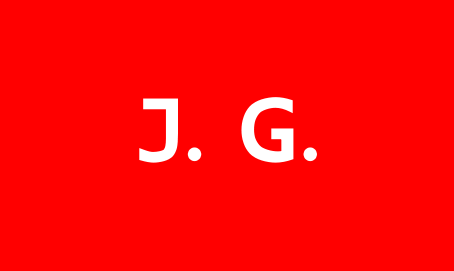
Jaluit Gesellschaft 1887
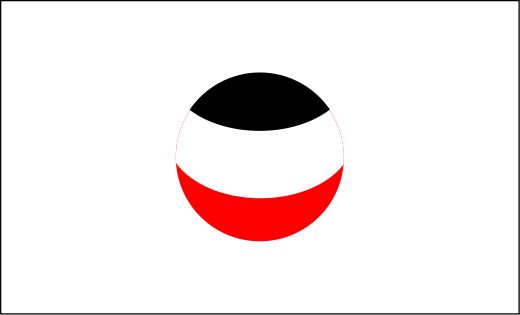
Jaluit Gesellschaft 1890
|
Jaluit Atoll Company 1887-1914
Later, the German trading companies DHPG, Hernsheim of Hamburg and Capelle from Likiep formed the Jaluit company (Jaluit Gesellschaft), which combined almost all trading interests in the Marshall Islands. The Jaluit Gesellschaft with trading stations on 18 of the 33 atolls and islands dominated the trade, and by 1902 most of the other companies had sold out to it.
After the outbreak of World War I in 1914, five Japanese warships landed troops at the Jaluit lagoon and took control over the Marshall Islands. After Jaluit had been taken peacefully, Japanese warships went through the atolls, announced that the Marshall Islands were now under Japanese control, removed German government officials, and informed the resident European traders, (including the Jaluit Atoll Company), that the Japanese now controled all island trade. The Jaluit Gesellschaft was replaced by Japanese companies.
The Jaluit-Gesellschaft at first used a a simple red flag with their initials written across the center in white, but the company changed the flag to a white field with a black and white and red colored circle in the Center apparently symbolizing the globe under German control. |
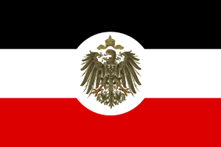
Flag for the Foreign office and "Reichskolonialamt."
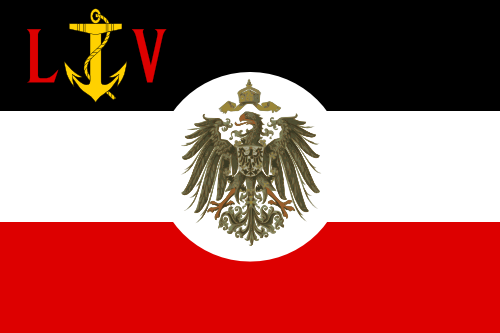
Flag for Pilots Authorities in the German colonies.
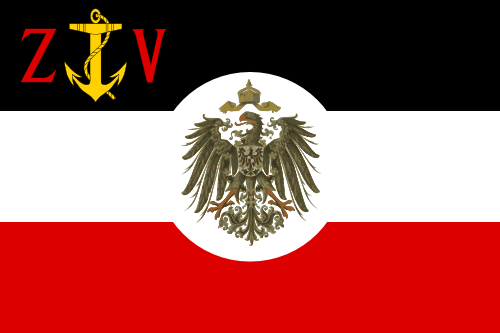
Flag for the Customs Authorities in the German colonies.
|
Imperial Flags for the Auswärtiges Amt (Foreign Office) 1893-1918
In April 1893, the Imperial Foreign Office received a special flag, consisting of the National colors Black-White-Red and the Reich eagle topped with the imperial crown. The eagle was centered on the flag within a white disk. This flag was to be used by authorities of the foreign office, including the authorities in the German colonies, for example, by most of their governors. With the new "Reichskolonialamt" (Reich Office for the Colonies) established in 1907, all tasks in the colonies were transferred from the "Auswärtiges Amt" to the Reichskolonialamt, which adopted the same flag as the Auswärtiges Amt.
In August of 1893, special flags, based on the flag for the Foreign office, were created for the Pilots and the Customs authorities in the German colonies. While the pilots flag was equipped with the red letters "L" and "V" (standing for "Lotsenverwaltung"), enclosing a yellow anchor, the customs flag got the letter "Z" instead of an "L" (standing for "Zollverwaltung"). These flags were to be hoisted on official buildings, as well as on ships and boats, and were in use until the outbreak of World War I in the year 1914.
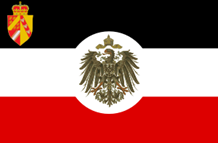
Flag for the Official Authorities in Alsac-Lorraine
In 1892, a flag was adopted for the authorities in the "Reichslande Elsaß-Lothringen" (Alsace-Lorraine). The area of Alsac and Lorraine was annexed by Germany after the war between Gemany and France in 1870-1871. Although the civil flag used in the Reichslande was the simple Black-White-Red striped flag, because the territory was then a part of Germany, it is interesting that the official authorities in 1893 received a flag that was based on the flag for the Foreign Office. The flag displayed the coat-of-arms of Alsace-Lorraine, which was placed in the upper left corner. This coat-of-arms was already adopted in 1891.
Click here to learn more about some Proposed Flags for the German Colonies made in 1914.
|
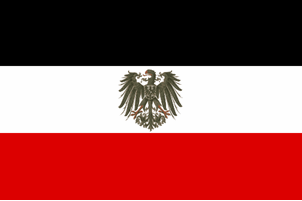
Colonial Governors´ Flag
German East Africa
and Kiautschau
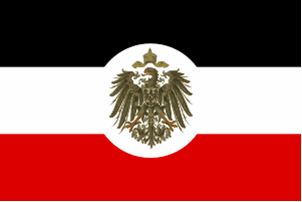
Colonial Governors´ Flag
Used in all other Colonies
|
Flags for the Governors of German Colonies 1891-1919
The first flag for a German governor in the colonies was adopted in March of 1891. It was used by Governor Julius Freiherr von Soden, who became the first German colonial administrator allowed to use that title. Prior to this the title "Reichskommissar" (Commissioner of the Empire) was used. Von Soden was first introduced as Governor for German East-Africa on January 1, 1891.
The flag for the Governor of German East Africa consisted of the Imperial national flag displaying in the center the Reichs-Eagle, but omitting the Imperial crown and the chain. It remained the Command Flag for the Governor of German East-Africa from 1891 until the area was occupation by Allied forces. The flag was only used as a command flag, i.e. it was only to be flown on ships and boats of the Governor and the Imperial Navy. The flag was not allowed to be used on land.
It is interesting that the governors of the remaining colonies had no special flag, rather they used the general flag for the Foreign office and the Reichskolonialamt. It is not clear why only the Governor of East Africa received a special command flag, and this is even more surprising because in 1898, the governor of the special area of Kiautschau, which was not a colony, but leased from China, also was given the right to fly the same flag as the Governor of East-Africa.
All that can be said is that the flag was also the command flag for the Governor of Kiautschau from March of 1898 until the occupation by Allied forces. Strangely, this right was never extended to any other German governor. |
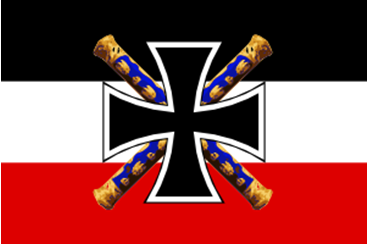
Boxer Rebellion Command
(Retangular Flag)
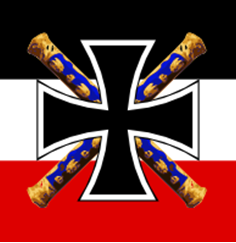
Boxer Rebellion Command
(Square Cavalry Standard)
|
The Commander-in Chief of the Armed Forces in China 1900-1901
The Boxer Rebellion, more properly called the Boxer Uprising, was a violent anti-imperialistic and anti-Christian movement in China between 1898 and 1900. In June of 1900, Boxer fighters, lightly armed or unarmed, gathered in Beijing to besiege foreign embassies. Finally, the Boxers declared war on the foreign powers that had diplomatic representation in Beijing. The result was that foreign navies started building-up their presence along the northern China coast in April of 1900. Among these troops were about 900 German soldiers, who in particular were later criticized for their enthusiasm in carrying out Kaiser Wilhelm II's spoken advise given during the departure ceremonies. He said "Just as the Huns a thousand years ago, under the leadership of Attila, gained a reputation by virtue of which they still live in historical tradition, so may the name Germany become known in such a manner in China, that no Chinese will ever again dare to look askance at a German."
The siege of Peking was finally ended when Indian troops of the international expeditionary force arrived under the command of German Field Marshal Alfred Graf von Waldersee. The main German force arrived too late to take part in the fighting, but undertook several punitive expeditions against the Boxers.
In August of 1900, Wilhelm II bestowed on Field Marshal von Waldersee, a unique command flag that was his as the Commander-in-Chief of the Imperial Armed Forces in China. This flag consisted of the national flag with an Iron cross on it. The cross was underlain by two diagonally crossed marshal's batons. This flag was used both as a rectangular flag and square standard, respectively. After the return of the German contingent in 1901 the flag was exhibited in a Berlin museum. |
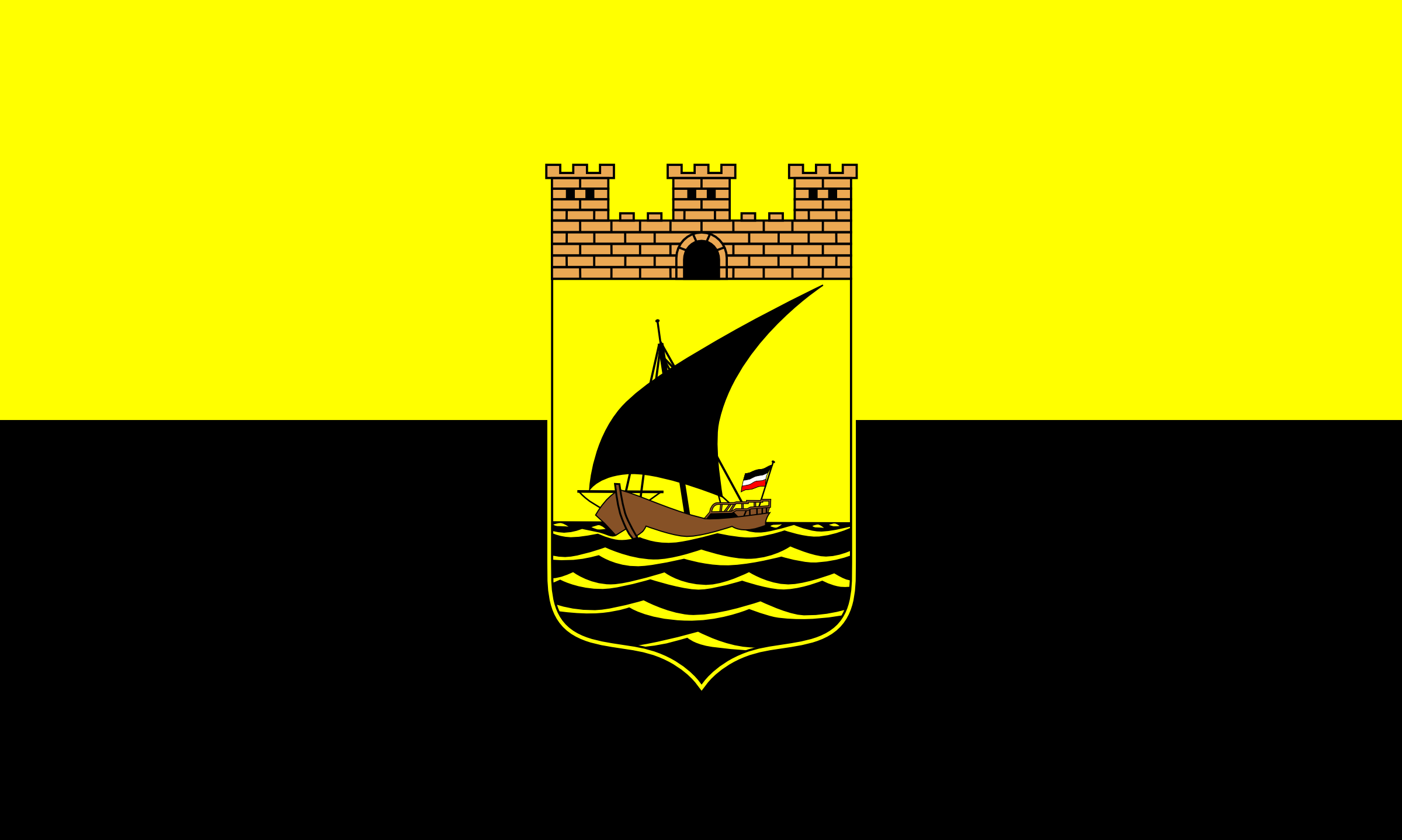
Proposed Flag of Tanga
(approved draft)
|
The Proposed Flags for the Town of Tanga 1914-1916
The Town of Tanga was located on the east-coast of the former German Colony of East-Africa. It had about 12.000 inhabitants in 1914. The City Council of Tanga decided to adopt a coat-of-arms and intended to adopt a flag with the shield placed in the center of it.
By the middle of 1914, the first draft for the coat-of-arms and flag was being examined by the "Heroldsamt" (Supreme Heraldic Office) in Berlin. The Heroldsamt recommended a few design changes which resulted in a second and final draft. However, the documents of the Supreme Colonial Office indicate that neither version of the arms nor any flag were ever officially approved and that the whole case was dropped after East Africa had been lost to the Allies. |
| Top of the page | The Holy Roman Empire | Prussian Flags Before 1800 | Prussian Flags 1800-1892 |
| Prussian Flags After 1900 | Imperial Germany Era Flags | German Colonial Flags | Weimar Republic Era Flags |
| Third Reich Era Civil and Political Flags | Third Reich Era Military Flags | Modern Era Flags |
Flags of the Weimar Republic 1919-1933
With the defeat of Imperial Germany by the Allied forces at the end of World War I, and the abdication of Wilhelm II in 1918, a new parliamentary republic was established in 1919 in Germany to replace the imperial form of government. It was named after Weimar, the place where the constitutional assembly took place, and became popularly known as the Weimar Republic, although interestingly enough, its official name remainded the "Deutsches Reich" or "German Empire."
In its 14 years the Weimar Republic was faced with numerous problems, including depression, hyperinflation, political extremists (and their paramilitaries), and the discriminatory regulations of the Treaty of Versailles. However, it overcame many of the discriminatory regulations, reformed the currency, unified tax politics, built an impressive railway system, and its brief existence actually represented a period of cultural innovation in Germany. Unfortunately, this liberal democratic government eventually fell victum to the increasing economic depression in the early 1930s, leading to the ascent of the NSDAP and Adolf Hitler in 1933.
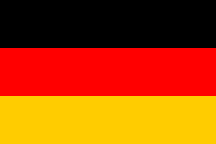
Weimar Republic
|
The Weimar Republic Flag 1919-1933
Black, red and gold in three equal horizontal stripes are the colors of the flag of the Federal Republic of Germany. The colors date to the emperors of the Middle Ages. They reappeared in the war against Napoleon when a corps of army volunteers drawn from all the German principalities adopted black uniforms with red braid and gold buttons.
Subsequently, student organizations, dedicated to the unification of Germany, used the colors on their banners. In the first attempt to create a democratic and unified Germany, leaders of the 1848 Revolution adopted the tricolor flag in the National Assembly or Frankfurt Parliament.
The flag was not actually used until 1918 when the German National Assembly of the democratic Weimar Republic adopted it officially. When Hitler came to power in 1933 he abolished the tricolor flag. In 1950, the flag was reintroduced by the German Parliament as the official symbol for the Federal Republic of Germany and is still used today.
|
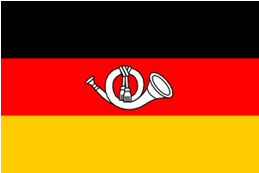
Weimar Postal Service Flag
1919-1921
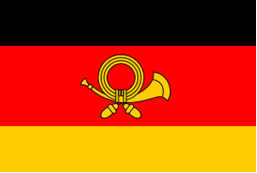
Weimar Postal Service Flag
1921-1933
|
The Weimar Republic Postal Service Flags 1919-1933
When in 1919, the German Empire was overthrown and new republican symbols were adopted, it was clear that also the Postal flag had to be changed. The former imperial postal flag not only consisted of black-white-red stripes, but also contained a post horn with a cord and tassels of black-white-red strands, and it used the Imperial crown, which topped the post horn.
In September of 1919, it was decided to introduce a new postal flag of black-red-gold colors, placing the post horn in the center of the red stripe. In view of the shortage of raw materials the only possibility was to use the material of the former imperial postal flags and manufacture the new flag out of this pieces of cloth. Thus the first postal flags looked very makeshift. Since it was not possible simply cutting out the imperial post horn and sewing it on the new flag a different post horn had to be designed.
As one stripe of the imperial postal flag was white, it was decided to form a completely white post horn. Soon there arose oppositions against this design and in 1921 a new postal flag was adopted. It showed a gold colored horn that appeared on a now widened red stripe. This flag continued to be used until 1933 when the Nazis again changed the National colors. |
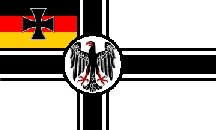
Weimar War Flag
|
The Weimar Republic War Flag 1919-1921
This was the Reichskriegsflagge adopted in 1919. It was never used, although samples were produced, because the old Imperial War Ensign of 1888 remained in use throughout this time period.
The new unused design was based on the previous imperial war ensign, replacing the eagle and the black-white-red canton with a black-red-gold canton.
( Click here to learn more about the history of the Imperial War Flag 1867-1921 )
|
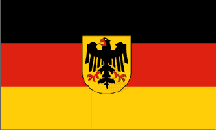
Weimar Service Flag 1921
(for use on land)
|
Weimar Service Flag on land 1921-1933
This design was used as the German flag by non-military official authorities and organizations. The black-red-gold is historically associated with "liberal" nationalism in Germany.
This flag was also called as the Dienstflagge der übrigen Reichsbehörden zu Lande (Service flag on land). This flag was abolished on April 22, 1933, by Adolf Hitler's government. |

Weimar Service Flag 1921
(for use at sea)
|
The Weimar Republic Service Flag at Sea 1921-1926
This was the flag normally used by all German Government Ships smaller than a warship at sea between 1921-1926. This flag was known as the Dienstflagge der übrigen Reichsbehörden zur See (Service flag on sea). It was replace with a new design in 1916 that featured the Weimar tricolor in the Canton. |
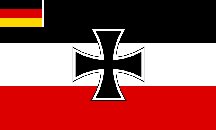
German War Flag
|
The Weimar War Flag 1922-1935
Since the leadership of the German Navy did not accept the new republican Reichskriegsflagge adopted in 1919 and refused to hoist the new version and insisted upon using the old Imperial War Flag of the German Empire, on January 1, 1922, this entirely new design replaced the War Flag of the German Empire.
It was in use between the years 1922-1935. It was replaced by the swastika type in 1935.
( Click here to learn more about the history of the Imperial War Flag 1867-1921 ) |
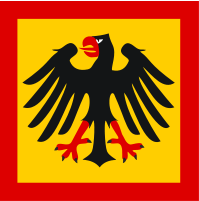
Reichspräsident Standard 1921
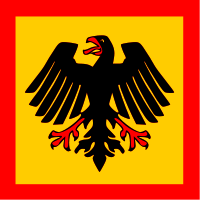
Reichspräsident Standard 1926
|
Flag and standard for the German Reich President 1919-1933
The Reichspräsident (Reich President) was the German head of state during the period of the 1919-1933 Weimar Republic. The first Reichspräsident was Friedrich Ebert who held the position from 1919 to 1925, followed by Paul von Hindenburg, who died in 1934. Contrary to the present Bundespräsident of the Federal Republic of Germany, the Weimar Reichspräsident posessed a lot of political power. For example, he appointed the Government: The Reichskanzler (Reich Chancellor) and his cabinet were appointed and dismissed by the Reichspräsident. Moreover, he could dissolve the parliament and was Commander-in-chief of the armed forces.
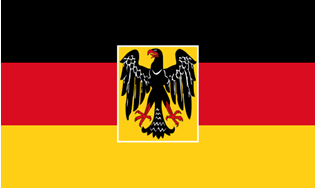
Reichspräsident Flag 1919-1923
The first insignia for the Reichspräsident was adopted in September of 1919 and was a rectangular shaped flag in the National colors Black-Red-Gold. In the center of the flag there appeared the Reichsadler (Reich eagle), laid down on a gold (yellow) colored, rectangular field, which had a small white border. Soon it became clear that this model was not at all satisfactory, because it looked rather like a national (state) flag. Thus in 1921 it was decided that the Reichspräsident was to be equipped with a square standard. On a yellow, red bordered square there was displayed a new designed Reichsadler. It is interesting to note that this standard virtually was identical to the present standard of the Bundespräsident of Germany. Regulations of 1926 introduced an alternative version of the standard. Apart from a slightly different shape of the eagle the main difference was an added sixth feather at each wing of the eagle. Contemporary pictures indicate that both, the five, as well as the six-feather version was used from 1926 to 1933, when the border of the standard was changed to black-white-red colors. |
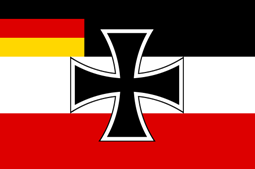
Weimar Navy Jack
|
The Weimar Republic Naval Jack 1921-1933
The Weimar Naval jack was adopted in September of 1919, however, owing to the flag conflict as to the "true" German colors, the jack wasn't actually used until January of 1922. Up to that point the former imperial naval jack, which displayed no black-red-gold canton, was in use. This jack (Gösch) was in use on German Naval ships until 1933.
On warships, the jack is flown from a flag pole (jack-staff) located on the vessel's front end (bow) when at anchor or in port. |
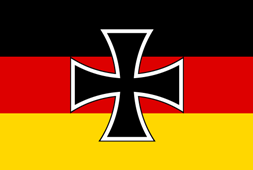
Weimar Defense Minister
|
The Weimar Republic Defense Minister's Flag 1921-1933
The Reichswehrminister (Defense Minister) was in times of peace the Commander-in-chief of the German Reichswehr. The Weimar Republic deliberately avoided the title "War minister."
The was actually the second variant of the War Minister's flag and adopted in 1921. It was similar to the first version adopted in 1919, but the proportions were changed from 3:5 to 2:3 and the Iron Cross was made thicker. |
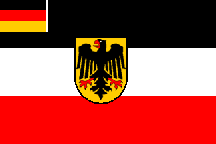
Weimar Service Flag 1926
(for use at sea)
|
The Weimar Republic Service Flag at Sea 1926-1933
This was the flag used by all German Government Ships smaller than a warship at sea between 1926-1933. This flag was also known as the Dienstflagge der übrigen Reichsbehörden zur See (Service flag on sea). It's use was abolished on March 31, 1933, by Adolf Hitler's government. |
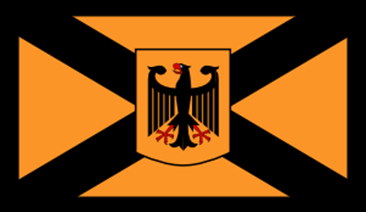
"Chef der Heeresleitung"
Command Flag
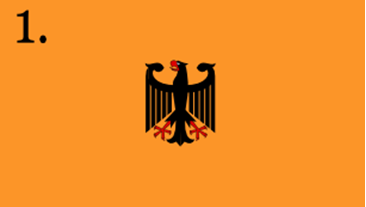
Commander Army Group 1
Command Flag
|
Weimar Republic Reichsheer (Reich army) Command 1927-1934
Limited by the Treaty of Versailles to a total of 100,000 men, the Reichswehr was a unified originization composed of the Reichsheer (Reich army) and Reichsmarine (Reich navy). The Reichsheer consisted of two group commands with seven infantry and three cavalry divisions, all in all. According to the Weimar constitution the Commander-in-chief of the Reichswehr was the Reich President, while in times of peace the Reichswehrminister (Reich Defense minister) took over the command.
The army was commanded by the "Chef der Heeresleitung" (Chief of the army), who were subordinated two group commands. In 1925, the Weimar Republic adopted special command flags for the Reichsheer-commands.
In 1927, the eagles displayed on the flags were modified. They then had almost the same shape as the present coat-of-arms of the Federal Republic of Germany.
The last "Chef der Heeresleitung" of the Weimar Reichsheer was Kurt Freiherr von Hammerstein-Equord who held the post between 1930-1934. |
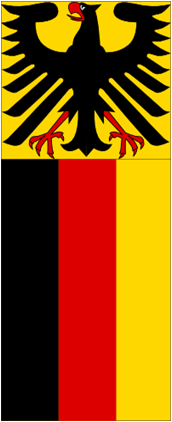
Weimar Reichsbanner
|
Weimar Republic Reichsbanner (German Reich Banner *) 1927-1933
An interesting flag in the Weimar Republic was the so-called "Reichsbanner" (Reich banner). It showed the national colors in a vertical position. On the top of the colors there was the "Reichsadler" (Reich eagle) on a yellow background, displayed in a special design.
Only adopted in 1927, this banner was manufactured in order to increase the popularity of the black-red-gold colors with the German people. It was to be used during all kinds of official festivities.
Obviously, the addition of a somewhat "imperial" looking eagle had the task of impressing those Germans, who were conservative and were grieving for the lost Empire. In fact, the Reich banner was a last, desperate attempt to increase the acceptance of the Black-Red-Gold colors within the German people. In 1927, hotels and even official buildings refused to hoist the black-red-gold colors, although it was the day of the German constitution. They insisted upon the former black-white-red flag of the Empire. Indeed, the famous hotel "Adlon" in Berlin hoisted the flag of the United States of America on the U.S. Constitution Day, but refused to do the same with the German flag on the German day of the constitution. This flag conflict was never solved
during the time of the Weimar Republic. As soon as the Nazis gained control over Germany in 1933, they almost instantaneously readopted the colors of the German Empire, Black-White-Red.
* Translation Note: you cannot translate the German word "Reichsbanner" as "German Empire banner." The word "Empire" was only used during the imperial time. Since there was no Emperor during the Weimar Republic, you have to use the words "German Reich banner," simply not translating the word "Reich." In German the word "Reich" does not always implicate an Empire and doesn't translate. |
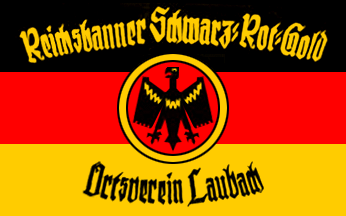
Reichsbanner
Schwarz-Rot-Gold
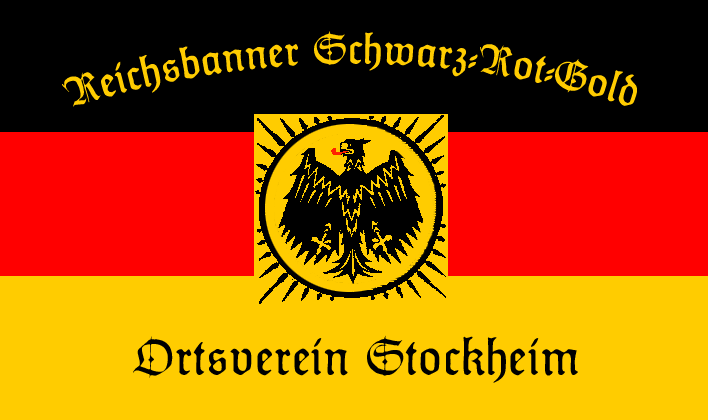
Reichsbanner
Schwarz-Rot-Gold
Stockheim Chapter
|
The Black, Red, Gold Banner of the Realm 1924-1933
(Reichsbanner Schwarz-Rot-Gold)
Another flag of the period that used the Reich Eagle was that of the "Reichsbanner Schwarz-Rot-Gold," a Social Democratic paramilitary force set up in the Weimar Republic in 1924. In February of that year, members of the SPD, the German Centre Party, the German Democratic Party and trade unionists in Magdeburg established what was basically their own private security army. Because Right wing and nationalist armed groups, like the Stahlhelm (Steel Helmet) or the SA, as well as the Communist Red Front Fighters had continued to radicalize and intensify the political struggle in the Weimar Republic, the Reichsbanner Schwarz-Rot-Gold saw its main task as the defense of the Weimar Republic against enemies from the National Socialist, monarchist and Communist camps.
Attempted coups in 1923, like the Hitler's far-right Munich "Beer Hall Putsch" and far-left "Hamburg rebellion" indicated the need for the paramilitary force, however, the deep social and economical currents existing in Germany at the time would soon overshadow any attempts by the Reichsbanner Schwarz-Rot-Gold to stem the raising tide of unrest.
The last federal general assembly of the "Reichsbanner" met in February of 1933 in Berlin. In March the Reichsbanner Schwarz-Rot-Gold was banned throughout the Reich by the Nazis. Members of the organization were systematically hunted down for deportation to concentration camps and partially exterminated.
Click here to learn more about the Weimar Era Political Militias.
|

German Tricolor
|
The German National Tricolor Flag 1932-1935
The German Imperial Tricolor flag was briefly reintroduced between 1933-1935 and used jointly with the Nazi Swastika Flag, then abolished in 1935 to try and prevent it being used by reactionary groups. |

German Naval Jack
|
The German War Ensign and Naval Jack 1933-1935
This was the flag used by all German warships between 1933-1935. It was replaced by the swastika type Naval Flag in 1935
On warships, the jack is flown from a flag pole (jack-staff) located on the vessel's front end (bow) when at anchor or in port. In the case of this flag it was also used as a regular ensign, or flag to be flown while at sea. |
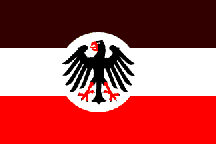
Civilian State Flag
(Used on land and sea)
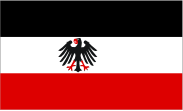
Military Service Flag
(For use at sea)
|
The German Service Flag 1933-1935
In March and April of 1933, a couple "new/old" Reichsdienstflagge (Service flags) designs (which used imperial colors) were approved for use: one used at sea by military ships, and one on land and sea as substitute for the civilian Service Flag which used the Weimar colors.
The first design shown here became the German State flag and ensign used between the years 1933-1935. The reason for this was because, although in March of 1933, the swastika flag was introduced as national flag, Paul von Hindenburg was still President of the Reich. Nothing could be done about the existing Weimar Republic Service flags without the agreement of the President.
In the end, President Hindenburg agreed to reinstate some of the former Imperial Service flag designs.
The German Service Flag for the Wehrmacht 1933
This particular State Service flag design was only used by the Wehrmacht between March 14, 1933, and April 21, 1933. After April 21, 1933, the Wehrmacht also used the Reich Service flag (1933-1935). This service flag was then used by all official authorities on land and sea, including the Wehrmacht, until the introduction of the Reichskriegsflagge (War flag) in 1935.
|
- My thanks to "Fornax" for all his expert help, research, advise, and images used on this page -
| Top of the page | The Holy Roman Empire | Prussian Flags Before 1800 | Prussian Flags 1800-1892 |
| Prussian Flags After 1900 | Imperial Germany Era Flags | German Colonial Flags | Weimar Republic Era Flags |
| Third Reich Era Civil and Political Flags | Third Reich Era Military Flags | Modern Era Flags |
|